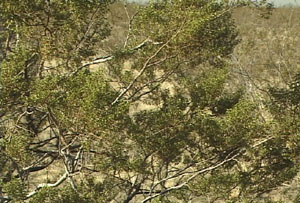
Photo #18 | Even hardy desert plants can be burned by chemical releases from nearby industrial facilities. |
Photo #19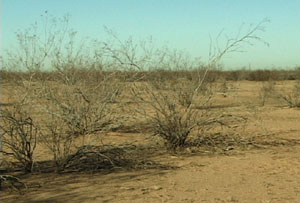 | Even hardy desert plants can be burned by chemical releases from nearby industrial facilities. |
Photo #20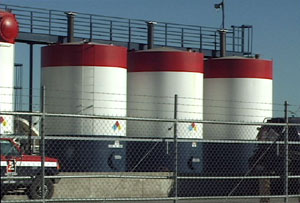 This facility illustrates some of the problems with overlapping federal
regulations. This facility handles and recycles hazardous wastes. Hazardous
wastes are not governed by EPCRA, and the facility would not have to report
the tanks of wastes under EPCRA. Hazardous waste disposal and recycling
facilities are instead governed by RCRA, but RCRA also requires a facility
emergency plan.
This facility illustrates some of the problems with overlapping federal
regulations. This facility handles and recycles hazardous wastes. Hazardous
wastes are not governed by EPCRA, and the facility would not have to report
the tanks of wastes under EPCRA. Hazardous waste disposal and recycling
facilities are instead governed by RCRA, but RCRA also requires a facility
emergency plan.
But this facility also "recovers" some used, dirty, solvents and sells these recycled solvents back to industry once the solvents are "cleaned" and purified to industrial grade. (This is considered a good thing because less solvents have to be created somewhere else.) By distilling the old, dirty, solvents and producing the "clean" solvents, the facility creates a fresh chemical, a solvent just like a regular solvent manufacturers would sell, and OSHA requires that the facility prepare an MSDS for these manufactured solvents. But a facility that manufactures solvents must report under EPCRA. The facility probably has to prepare a facility emergency plan under RCRA, and should report under EPCRA for its solvents if the amount on-site reached the RQ, Reportable Quantity, of the solvent. The BOLDER Project has the answer for these types of regulatory redundancies. Instead of having separate emergency plans, the BOLDER Project allows this facility to prepare just one emergency plan that integrates the information throughout the facility into one emergency plan. Great idea. Note the fire diamonds on the tanks and the colors that make the tanks aesthetically pleasing. |
Photo #21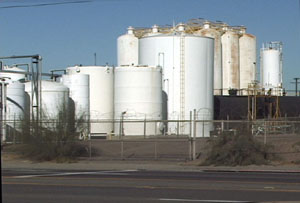
| This facility has enormous amounts of a variety of EHS chemicals and OSHA chemicals stored on-site. There is enough Hydrofluoric Acid on-site, over 260,000 pounds, to have impacts quite a distance away in the event of a catastrophic release or spill. A large freeway interchange is within a half mile. |
Photo #22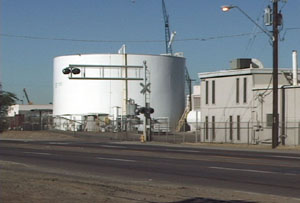
|
This facility reported large amounts of Anhydrous Ammonia, Ammonium
Fluoride, Ammonium Hydroxide, Ammonium Polysulfide, Ammonium Thiosulfate,
Potassium Thiosulfate, Sodium Hydrosulfide, and Sodium Hydrosulfide and
Ammonium Sulfide Blend on its Tier Two Reports. Can you tell which tank is
which? Imagine trying to respond to an emergency incident at this facility.
Even Tier Two Reports have their limitations, which is why the BOLDER
Project is so useful. By using the BOLDER Project's software, the fire
department will know exactly which tank has what chemical in it, how far
away the impacts could reach, and how to respond efficiently.
This facility did not have a facility emergency plan on file until concerned citizens raised questions about its availability. |